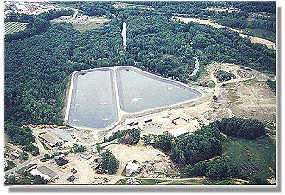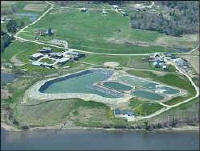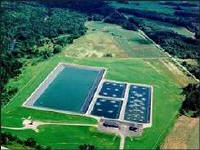|


Background
Lagoons and ponds refer to basins
constructed in, or on the ground surface, using earthen dikes to
retain wastewater within which natural stabilization processes
occur with the necessary oxygen coming from atmospheric diffusion,
photosynthetic and/or mechanical sources. In Maine, most of the
lagoons and ponds are partial mix aerated lagoons and facultative
stabilization ponds. Some of these facilities have experienced
problems meeting biochemical oxygen demand (BOD5) and total
suspended solids (TSS) permit requirements. More recently, it has
been recognized that nitrification occurs in these systems and that
the effects of nitrification may be measured in the BOD5 test.
Maine Task Force
In 1994, a Maine Department of
Environmental Protection (DEP) staff committee was formed to evaluate
the performance of lagoons and ponds. The DEP staff presented its
findings and recommendations at a public workshop on October 24, 1995.
During that workshop, several issues were identified and workshop
participants agreed that a task force should be established to resolve
the issues.
A task force made up of DEP staff,
consulting engineers and lagoon treatment plant operators held its
first meeting on December 13, 1995. The task force identified problems
(BOD5, TSS and pH) at some of the lagoons and ponds and agreed that it
would work to produce written, experience-based guidelines,
recommendations and collaborative procedures for the licensing,
design, and operation of these systems. The task force further agreed
that the guidelines, recommendations and procedures would promote
cost-effective, environmentally-sound and flexible industry practices
which recognize the interrelationship of everyone concerned. After
nearly 18 months of work, the task force prepared this manual. The
following is a summary of the task force's findings and
recommendations.
Findings : Lagoons
and ponds have unique design and operation requirements in comparison
to high rate treatment systems.
Lagoons and ponds are thought of as
simple systems that trade size (land area) for mechanical complexity,
energy use and operation and maintenance intensity. The larger
treatment volume in the ponds results in physical and biochemical
inertia that tends to keep them on course. This is beneficial when
treatment is good, but makes operation difficult when problems occur.
The performance of lagoons and ponds is highly dependent on their
initial design and proper operation as well as the characteristics of
the microorganisms in the system. Lagoons and ponds are affected by
seasonal changes, e.g., spring benthic demand, summer algal blooms,
autumn algal die-off and winter cold temperatures. These concerns are
unique to lagoons and ponds and need special design and operational
considerations.
Recommendations:
Operator training and
technical assistance for lagoon operators should be developed and
provided for operators in Maine. A network of lagoon operators should
be established to promote the exchange of operator experience and new
control strategies. Operators should develop specific operational
plans for their facilities that account for all of the seasonal
changes (i.e., spring turnover, algae and nitrification in the summer,
and winter cold). Design engineers should design for these seasonal
variations and, in particular, recognize that partial nitrification
and denitrification do occur in lagoons and may result in higher BOD5
and that algal growth can be significant and may result in high
effluent TSS.
Finding : Overall, most of the lagoons
and ponds in Maine are meeting secondary treatment permit requirements
for BOD5 and TSS.
The task
force found that most of the lagoons and ponds in Maine' can meet
secondary treatment requirements of 30 mg/L monthly average BOD5 and
TSS. The data from plant performance indicates that half of the POTWs
achieved a BOD5 effluent quality of less than 25 mg/L and a TSS of
less than 22 mg/L 95 percent of the time on a monthly average basis.
The task force found that some lagoons and ponds do not meet secondary
treatment, but do meet "equivalent to secondary treatment" (45 mg/L
monthly average) for effluent BOD5 and TSS due largely to varying
climatic and seasonal conditions. In the late winter and early spring,
BOD5 problems occur primarily because of reduced biological treatment
activity due to the colder temperatures. In the warmer months, algae
cause increases in effluent TSS and also increases the apparent
effluent total BOD5.
Recommendation:
Adjust BOD5 and TSS permit limits on a case-by-case basis for
facilities with problems due to cold weather and algae.
The Task
force recommends that effluent BOD5 and TSS concentrations could range
up to a maximum of 45 mg/L as a 30-day average when:
-
a) the
facility cannot consistently achieve secondary treatment defined as
a 30-day average of 30 mg/L 95 percent of the time based on at least
three years of monthly average data,
b) the facility provided information and data to demonstrate that
the problem is uncontrollable while using a properly designed and
operated lagoon or pond as the principal biological treatment
process, and
-
c) there
are no extenuating circumstances such as overloading or industrial
wastes.
The task
force recommends that a facility not be allowed to obtain effluent
limitations that are any less stringent than the level of effluent
quality that the facility is capable of achieving within the range of
30 - 45 mg/L. That level should be defined based on the 30-day average
achieved 95 percent of the time over the last three years for the
seasonal period of non-compliance.
Finding: BOD5 is
misleading as a performance indicator for some facilities.
The 5-day biochemical oxygen demand
(BOD5) test is currently used to determine the operating efficiency of
lagoons and ponds and the quality of their effluent. The task force
found that BOD5 is a misleading parameter for measuring the treatment
performance of some aerated lagoons.
The task force identified a fundamental
misunderstanding regarding the relationship between effluent BOD5 and
treatment performance. Treatment performance relates to how well the
system removes the influent BOD5, whereas effluent quality is measured
by the BOD5 in the effluent. For some lagoons and ponds, effluent
quality does not reflect treatment performance. In fact, very little
of the BOD5 in the effluent of a lagoon or pond is residual influent.
Some of the effluent BOD5 (in the summer) is caused by algae. In
addition, the effluent BOD5 is often inflated by nitrification in the
BOD5 test during the warmer months.
The task force also found that the use
of BOD5 may lead to unintended, undesirable outcomes. The BOD5 test
measures the oxygen utilized in a 5-day period for the biochemical
degradation of organic material (carbonaceous biochemical oxygen
demand, CBOD5) and the oxidation of reduced forms of nitrogen, such as
ammonia and nitrite (nitrogenous oxygen demand). Significant
nitrogenous oxygen demand can be exerted when sufficient numbers of
nitrifying bacteria and ammonia (or nitrite) are present in the test
sample. In other words, BOD5 test results of the effluents from
lagoons and ponds exhibiting partial nitrification may have higher
values than other systems with either no nitrification or complete
nitrification3 even when overall treatment for BOD5 is satisfactory or
better than facilities that are not nitrifying.
Recommendation: Substitute
CBOD5 for BOD5 in some cases.
In order to reduce their BOD5 values to
meet compliance requirements, some operators try to suppress
nitrification when they are not required to meet ammonia limits. This
practice usually results in increased effluent toxicity and oxygen
demand on the receiving waters. Therefore, to eliminate this situation
and because the BOD5 test is not reflective of effluent quality under
nitrifying conditions, the task force is recommending that a monthly
average CBOD5 limit Of 25 mg/L be substituted for the current 30 mg/L
monthly average BOD5 on a case-by-case basis when:
Prior to relicensing facilities that
have CBOD5 limits, the licensee and DEP should develop a procedure to
determine whether nitrification is still occurring. This procedure
should include submittal of information and data as outlined in
conditions a) and b) above for the year prior to relicensing.
Finding: The
literature and available knowledge about the management and control of
sludge accumulation and algal growth in lagoons and ponds is limited.
Recommendation:
Organizations that are
interested in the operation of lagoons and ponds should continue to
support the research of the management and control of sludge
accumulation and algal growth in lagoons and ponds.
Finding: The
current DEP 49 Form is designed for activated sludge systems.
Recommendation:
The DEP should revise the 49 Form for
parameters typically used at lagoon facilities and allow facilities to
tailor it specifically for each individual lagoon system as needed.
Finding: The
existing DEP data management system is inadequate, cumbersome, and
inefficient.
Recommendation:
Provide a computer system at lagoon
facilities to store historical treatment reporting data and a means to
transport data over a telephone line. The DEP should develop a
computerized data management system to receive and store the data sent
electronically.
Finding:
Most of the
lagoons in Maine are meeting secondary treatment permit requirements
and are generally similar.
However, there is a wide variety of
flexibility and amenities, i.e., the size and type of facilities,
building space and layout, provided from one facility to another.
The newer facilities have benefited from
the earlier lagoon designs, operational experience, and the
advancement in technology. Those lagoon facilities with greater
flexibility, such as, additional storage capabilities or long
detention times, structures to vary the water level within lagoons,
the latest equipment systems, i.e., grit removal, screening,
instrumentation, and flow proportional discharge capabilities were
found to produce high effluent quality along with being cost
effective. Also, the operators task of meeting secondary permit
requirements was made easier.
Recommendation:
Adequate funding should be
available to provide a consistent level of wastewater treatment and
for the completion of the facilities.
Footnotes
A common misconception is that
effluent BOD5 is residual influent BOD5- influent BOD5 is made up of
two fractions -a particulate fraction and a soluble fraction. In
waste stabilization ponds, most of the particulate fraction is removed
within hours by physical entrapment and adsorption. Removal of the
soluble fraction takes a few days. Even at 10* C, the predicted
effluent soluble BOD5 is less than 10 mg/L. Most of the particulate
BOD5 in the effluent of waste stabilization ponds results from algae.
Each milligram per liter of algae in the effluent exerts approximately
0.5 mg/L of BOD53As a rule-of-thumb, whenever the BOD5 values are
greater than two-thirds of the corresponding TSS values (during the
warmer months), the BOD5 values have been inflated by nitrification.
Whenever the BOD5 values exceed those of the TSS, nitrification is
significant.

|

